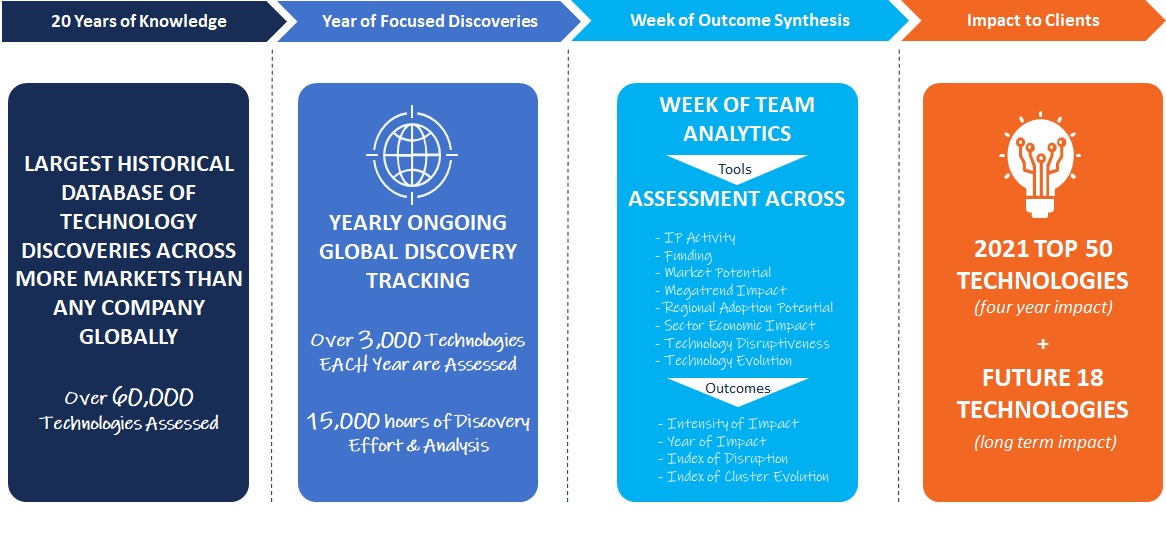A Top 50 Technologies for the Future Platform
I love the Alvin Toffler quote, “The great growling engine of change—technology,” for a host of reasons. “Growling” could be overlooked for “change” simply because we are caught in an era and pace of change that leaves our heads spinning, and strategy executives love to talk about change. However, the deliberate use of growling denotes a sense of hostility. My interpretation of this word choice is the foresight to know that technology is an incredibly fickle and risky proposition, and fickleness has a high propensity to create hostile responses based upon our given perspective.
This is exemplified by our 2021 Edition of the Top 50 Emerging Technologies, which showcases technologies at a technology readiness level (TRL) of 5 to 9. Our team spent tens of thousands of hours determining the standouts for the next several years and assessed their viability across our criteria (see chart 1). Our top technologies cannot be ignored, especially with a tidal wave of end-user needs spurred by the recent geopolitical chaos (COVID-19, elections). This has created a renewed view of the impact these technologies can have on many applications.
Chart 1
 One of the top technologies, graphene sensors, has been in the spotlight over the past few years with varying levels of funding, growth of applications and media attention. Graphene is a two-dimensional material comprised of carbon atoms. It is only one atom thick and more than 200 times stronger than steel. It has incredible density, flexibility and is the most conductive material on earth. But it has other superpowers! It is also transparent and lightweight—the superfood of materials. Graphene provides growth for a range of sensor applications. Given its attributes, it has disruption potential in all of the main sensor categories, including image sensors, motion sensors, accelerometers and biosensors.
One of the top technologies, graphene sensors, has been in the spotlight over the past few years with varying levels of funding, growth of applications and media attention. Graphene is a two-dimensional material comprised of carbon atoms. It is only one atom thick and more than 200 times stronger than steel. It has incredible density, flexibility and is the most conductive material on earth. But it has other superpowers! It is also transparent and lightweight—the superfood of materials. Graphene provides growth for a range of sensor applications. Given its attributes, it has disruption potential in all of the main sensor categories, including image sensors, motion sensors, accelerometers and biosensors.
For the past five years, activity has increased steadily with companies exploring use cases for graphene, ranging from heat sensitivity monitoring to climate and chemical sensors. Now, there are fast and furious applications in disease diagnosis because its sensitivity capabilities are much more efficient than traditional sensors. Biosensors, in particular, show a rapid adoption path as we emerge from the COVID-19 crisis with rapid screening tests as well as applications in areas like wound care. Graphene’s application diversity makes it an ideal candidate for widespread adoption due to reduced cost sensitivity and clearer paths to commercialization at scale. Its use in image sensors, where you can see dramatic improvements in response speed and sensitivity, especially in far infrared sensors, is displacing thinking that quantum-based sensors may be the best option. For this reason, and the degree to which it will disrupt traditional approaches, the field of graphene sensors was an easy addition to our Top 50 Technologies for 2021 list (see chart 2).
Chart 2

We began with thousands of technologies before narrowing our list to the top 50. Utilizing our platform, you can assess the implications of the rapid pace of development on your technology development roadmaps. With a unique view into success factors, cost of development, and partner networks, we mapped the primary attributes of these technologies onto a platform that helps you understand your own developments and identify potential opportunities to enhance your roadmap and mitigate risk.
So, who needs to be involved in these discussions? Working in this field for more than two decades, I have observed the barrier between what I would describe as emerging technologies and the ability of technology practitioners—the developers—to capture and maintain executive-level attention. This takes us back to the word “growling.” It is not that senior executives view these technologies as “hostile,” but rather a translator is required to captivate interest and provoke a reaction. We worked hard on this element to ensure the Top 50 list is balanced. There are many technologies on our list that people will recognize by name, understand little of in terms of depth, and feel a degree of hostility toward because the tech term has been heard so often. In many ways, executives become hardened to some technology terms, like virtual reality (not on our 2021 list). When a technology makes our list, be assured technology and commercial specialists agree it is a whisper worth shouting about. Our methodology (see chart 3) has been pressure tested over the past 11 years, allowing us to return to our work each year. We are proud of our discoveries, and we make our body of work, in its entirety, accessible to our subscribers.
Chart 3

As professionals, our careers are often assessed on our ability to identify critical technology growth opportunities and mitigate the inherent risk associated with our choices. One important consideration is how these technologies converge to create unique technology profiles that previously would not have been considered. Our Top 50 Platform is a highly effective, low-risk tool that can be added to your toolkit to enhance your decision-making by being more thorough and introducing elements of out-of-the-box perspectives that are necessary in today’s rapid and, yes, hostile technology growth environment.
To access Frost & Sullivan’s 2021 Edition of the Top 50 Emerging Technologies, click here.



